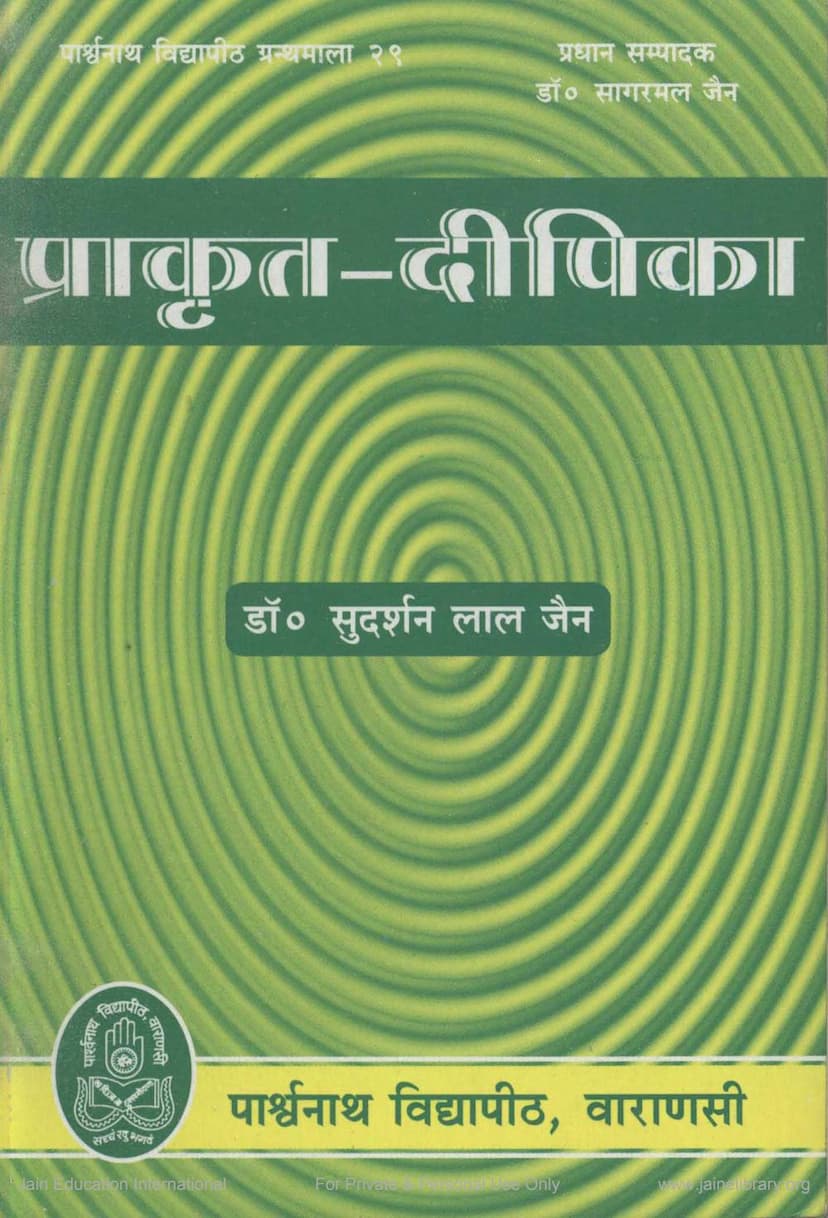Prakrit Dipika
Added to library: September 2, 2025

Summary
Here's a comprehensive summary of the Jain text "Prakrit Deepika" by Sudarshanlal Jain, based on the provided information:
Book Title: Prakrit Deepika Author: Sudarshanlal Jain Publisher: Parshwanath Vidyapith, Varanasi Catalog Link: https://jainqq.org/explore/001669/1
Overview:
"Prakrit Deepika" (The Lamp of Prakrit) is a significant work aimed at making the Prakrit language accessible to students and scholars, particularly those familiar with Sanskrit. The book was published by Parshwanath Vidyapith, Varanasi, as part of their "Jain Vidyapith Granthamala" series. The text highlights the crucial role of Prakrit in understanding ancient Indian civilization and culture, lamenting the gradual decline in its study and teaching. The book is presented as a bridge for Sanskrit students to learn Prakrit through a method that aligns with Sanskrit's structure and style.
Key Themes and Content:
-
The Importance of Prakrit:
- Prakrit is described as the "mother" of Sanskrit, the natural language from which Sanskrit, the "cultivated" language, evolved.
- Prakrit was the language of the common people for centuries, while Sanskrit remained a literary language for the learned.
- The founders and acharyas of Jainism and Buddhism adopted Prakrit to connect with the masses.
- A vast portion of ancient Indian literature is preserved in Prakrit.
- Knowledge of Prakrit is essential for comprehending ancient Indian civilization, culture, history, and philosophy.
-
The Genesis and Evolution of Prakrit:
- The book discusses various theories on the origin of Prakrit, including its derivation from Sanskrit and from Chandas (Vedic language).
- It acknowledges that while Sanskrit was often used to explain Prakrit, the "Janbhasha" (common people's language) aspect of Prakrit suggests a parallel development from a common Indo-Aryan source, with Prakrit often exhibiting more primitive features than Classical Sanskrit.
- The text emphasizes that Prakrit is not a single language but a group of languages that developed through stages:
- First Stage (Spoken Language, c. 2000 BCE - 600 BCE): The precursor to later Prakrits, glimpsed in Vedic literature.
- Second Stage (Literary Prakrits, c. 600 BCE - 900 CE): The period of literature-bound Prakrit languages like Pali, Paisachi, Shauraseni, Magadhi, and Maharashtri.
- Third Stage (Modern Languages, post 900 CE): Languages like Hindi, Marathi, etc., which evolved from Apabhramsa (the intermediate stage between Prakrit and modern languages).
-
Structure and Methodology of "Prakrit Deepika":
- The book is divided into three main parts: Grammar, Translation, and Compilation.
- Grammar: This section is meticulously organized, covering:
- Alphabet and Phonetics: Including sound changes (vowel and consonant transformations, assimilation, dissimilation).
- Gender and Declension: Discussing changes in noun genders and the paradigm of declensions.
- Sandhi (Vowel and Consonant Combinations): Explaining the rules of joining sounds.
- Krit and Taddhit Prefixes: Detailing the formation of words from roots and bases.
- Affixes: Covering feminine affixes and indeclinables (avyayas) and prefixes (upasargas).
- Case System (Karak): Explaining the use of various case endings.
- Compound Words (Samas): Analyzing different types of Sanskrit-style compounds.
- Noun and Verb Conjugations: Providing tables for common noun and verb forms.
- Derived Verbs: Explaining the formation of causatives, intensive verbs, etc.
- Various Prakrit Languages: A significant section detailing the characteristics of Maharashtri, Jain Maharashtri, Shauraseni, Jain Shauraseni, Magadhi, Ardhamagadhi, Paisachi, Chulika-Paisachi, and Apabhramsa. This comparative linguistic approach is a key feature.
- Translation: This part includes lesson-based exercises with example sentences, focusing on various tenses (present, past, future, imperfect, conditional), moods (imperative, subjunctive), and sentence structures (causal, relative clauses, passive voice). Each lesson is followed by practice sections.
- Compilation: This section contains excerpts from various Prakrit literary works, categorized by language (Maharashtri, Jain Maharashtri, Ardhamagadhi, Magadhi, Shauraseni, Jain Shauraseni, Paisachi, Chulika-Paisachi, Apabhramsa). The selections include prose and poetry, covering simple, literary, didactic, philosophical, and conversational styles.
- Appendices: A glossary (Shabdakosh) and a verb index (Dhatukosh) are provided to aid translation.
- Methodology: The author emphasizes providing parallel Sanskrit forms, Sanskrit derivations for Prakrit words, explanations in Hindi, footnotes with Prakrit grammatical rules (especially from Hemachandra), and linguistic insights.
-
Dedication and Acknowledgments:
- The second edition is dedicated to the author's parents. The first edition was dedicated to notable Prakrit scholars Pt. Bechardas J. Doshi and Pt. Dal Sukhbhai Malvania.
- The publication acknowledges the support of Parshwanath Vidyapith, its officials, and staff, highlighting the book's popularity as evidenced by the sale of 1000 copies of the first edition.
Key Features of the Book:
- Comprehensive Grammar: Covers most aspects of Prakrit grammar systematically.
- Comparative Linguistics: Excellent section detailing the characteristics of different Prakrit vernaculars, making it a valuable resource for linguistic study.
- Practical Approach: Includes translation exercises and a compilation of texts for practical application.
- Sanskrit-Learner Friendly: Designed to leverage the knowledge of Sanskrit students.
- Scholarly Rigor: Cites sources and grammatical rules from prominent Prakrit scholars like Hemachandra, Vararuchi, and Markandeya.
- Historical Context: Places Prakrit within the broader history of Indian languages.
In essence, "Prakrit Deepika" serves as a foundational text for learning Prakrit, bridging the gap between Sanskrit and the vernaculars, and offering a deep dive into the linguistic and literary richness of Prakrit and its various dialects, thereby contributing significantly to the preservation and dissemination of Jain and Buddhist heritage.